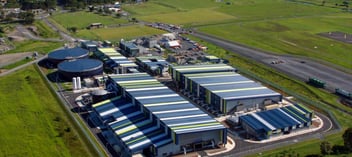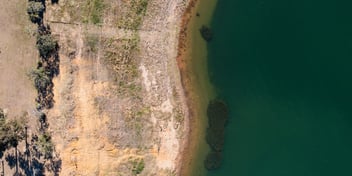South East Queensland prepares for possible drought

Last month, the Bureau of Meteorology declared that El Niño and a positive Indian Ocean Dipole are officially underway, with warmer and drier conditions more likely over spring and summer for parts of Australia.
But communities in South East Queensland are already feeling the effects.
In August, Urban Utilities and Seqwater activated the drought response plan for the Canungra community, after flows in Canungra Creek fell below 7ML per day.
Urban Utilities CEO Paul Arnold said Canungra is one of 12 off-grid communities in South East Queensland that is not connected to the SEQ Water Grid – the region’s network of dams, water treatment plants, reservoirs, pump stations and pipelines.
“The town’s water source, Canungra Creek, is fed from springs in the Lamington Ranges. To maintain its flow, the springs rely heavily on an annual wet season recharge, along with regular rainfall top-ups throughout the year,” he said.
“When the Canungra Creek catchment has a dry wet season, like we saw earlier this year with total rainfall around half of what we’re used to seeing, the flow in the creek can reduce faster and sooner than it would have in previous years.”
Both Urban Utilities and Seqwater recognise the impact drought can have on communities and are committed to keeping customers well informed, Arnold said.
“The Canungra community has told us that early communication about drought response is important and we work closely with Seqwater to keep our customers updated. At present, we’re encouraging the community to continue using water efficiently around their homes and gardens as part of the ‘drought readiness’ phase,” he said.
“Water restrictions will be introduced if Canungra Creek flows continue to reduce and Seqwater begins tankering drinking water to supplement the town supply.”
Seqwater CEO Neil Brennan said Seqwater is tracking flows in the creek daily and will continue working closely with Urban Utilities to make sure drinking water demands are met.
“We know the flows in Canungra Creek can change quickly in response to weather and drought so we will continue working with Urban Utilities to provide the community as much notice as possible as we move through the drought plan,” he said.
“Recent history highlights South East Queensland can experience big climate swings from year to year, which we factor into our planning. Right now, we’re getting ready for the possibility of drought.”
SEQ Drought Response Plan
South East Queensland’s Drought Response Plan is a multi-staged strategy that sets out what actions are taken to prepare and respond for drought, Brennan said.
“This includes how Seqwater will operate the SEQ Water Grid to optimise available water resources, and how we, alongside water retail companies, will raise community awareness about the need to use water wisely,” he said.
“At the drought readiness level, we focus primarily on community awareness and education. While there is plenty of capacity in the grid, one of the key lessons learnt from the Millennium Drought was the importance of having early public conversations about being mindful of water use.”
Arnold said that if forecasts for warmer and drier conditions in the coming months hold true, modelling suggests that the SEQ Water Grid supply could fall below 60% as early as January 2024.
“[The 60% mark] is the trigger in the South East Queensland Drought Response Plan for ‘drought response’ or voluntary water conservation measures,” he said.
“Once triggered, we increase our water saving messages to the community in an effort to reduce residential water usage to 150L per person per day to ease the pressure on our drinking water storages.”
When the SEQ Water Grid falls below 70%, the region enters the ‘drought readiness level’ of the plan, Arnold said: “This is an important milestone during which we communicate with the community about the current water supply situation to create a greater awareness”.
“By preparing the community ahead of time, keeping them informed of the current supply situation, the future weather forecasts and what that might mean for grid storages, they will be more ready to respond when called upon if drought progresses.”
Water security
If drought does progress, Brennan said there are further actions available to bolster water security, depending on location and need.
“Thanks to investments in the SEQ Water Grid and ongoing water security planning, South East Queensland has a safe, reliable and resilient water supply network,” he said.
“Having the SEQ Water Grid and climate resilient assets means we now have more options to manage water supply challenges arising from sporadic rainfall, drought, climate change and population growth.
“Off-grid communities benefit from these assets too if required, as we cart water from the grid into these communities when local water supply becomes low or stops.”
Seqwater uses the SEQ Water Grid to move water around and top up supply when needed, Brennan said, with the Gold Coast Desalination Plant playing an important role in supplementing supplies as needed to preserve dam levels.
“The Western Corridor Recycled Water Scheme remains an important drought response measure. It is also currently used to supply industry, particularly power stations, to reduce demand on Wivenhoe Dam, South East Queensland’s largest drinking water storage,” he said.
“Having these mix of water sources available is important to ensure the resilience of the SEQ Water Grid in drought conditions.”
Arnold said Urban Utilities supports an ‘all-options on the table’ approach to water security, including utilising climate-independent sources of water, such as desalination and purified recycled water.
“South East Queensland already has access to climate-independent infrastructure built during the Millennium Drought and it makes sense to use this to support the region’s water security,” he said.
“Using an asset the region already has, such as the Western Corridor Recycled Water Scheme, would also help keep downward pressure on bills for our customers.”
Guiding community
Under the drought response plan, Seqwater will continue working alongside the water retailers to provide updates on storage levels and encourage the community to undertake simple water smart actions.
“We know South East Queenslanders are responsible and responsive water users and will look for ways to make simple water savings when asked,” he said.
“These efforts are appreciated, and together with grid operational decisions, can help delay and even potentially avoid the need for mandatory restrictions should South East Queensland experience a prolonged drought.
Arnold said an important part of any drought plan is to care for the water available today and to create the water needed for the future.
“We can all help care for our water today by continuing to use water efficiently. Creating the water we need for the future means increasing our water reuse and looking to other more resilient sources of water to help supplement our drinking water supplies,” he said.
“We play an important role in shaping the future of water for our customers and communities.
We can’t take our water for granted. Our drinking water supplies are under pressure from population growth and climate change and we must secure them for the future.”


